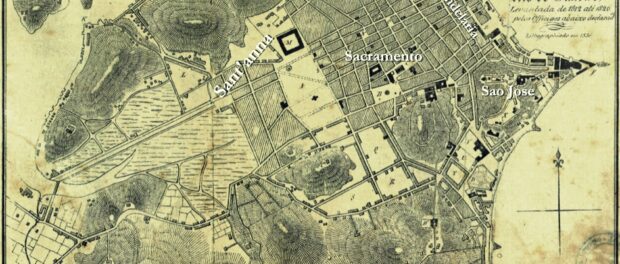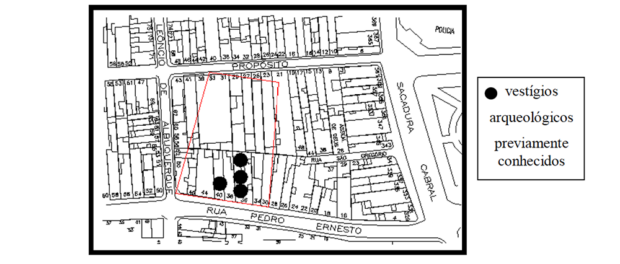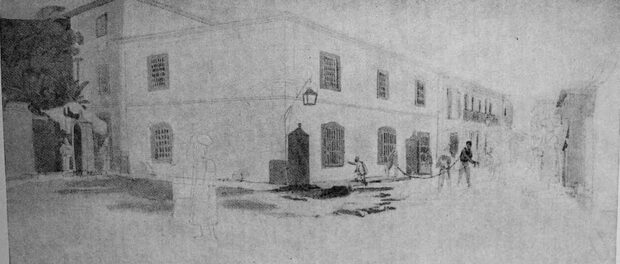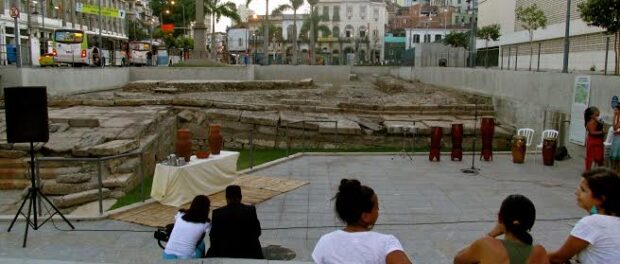
This is the first of a two-part series on Rio de Janeiro’s Port Zone.
“The Port Zone will be the gateway to the Rio de Janeiro Olympics:” Since the port revitalization projects of Porto Maravilha began to be implemented in 2011, it has become common to hear that the region encompassing the Port neighborhoods of Gamboa, Saúde and Santo Cristo will be the gateway for tourists arriving in the city. The assumption is that a place receiving visitors should be representative of the rest of the city, of its impressions of beauty, progress and development. But which Rio de Janeiro does the Port Zone show, if we come through this “gateway” with a critical outlook, deeper and more nuanced than a typical tourist? What can this place say about the rest of the city and the type of logic that directs its development?
For the photographer Maurício Hora, who was born and raised in Morro da Providência, Brazil’s first favela, today over 117 years old, the renovation projects accompanied by the exponential growth of living costs have built a Port Zone that is progressively excluding the poor and black population from the region and its projects: “They talk about the ‘Circuit of African Heritage‘ but where are the people? Where are the blacks who live here? (…) They are being removed. In a very subtle way, but they are being removed.”
When not caused by forced removals and expropriations, it is economic pressure that is driving the migration of historic residents, the resulting transformation of the communities formed there, and the selective erasing of the area’s history. On Barão de Gamboa Street, for example, lived Seu Paulo, Mauricio says: “He practiced an Afro-Brazilian religion and had a terreiro [religious gathering place] there. They suggested he sell the house and buy another one, and he left the region. Seu Paulo had to be here!” Seu Paulo’s meeting place is not the only historically black space that’s been expelled from the region. Urban occupations in buildings that had been abandoned for years have also disappeared after becoming targets of evictions in the last years, like the occupations of Zumbi dos Palmares, Casarão Azul, Machado de Assis, Flor do Asfalto and Quilombo das Guerreiras, all evicted in the last five years.
The Port Zone has been a stage for removals, evictions, demolitions and the burial of memories, culture and black presence in the name of “progress” and “beautification” of the city for a long time. One of the first urban planning documents of Rio de Janeiro, the Relatório Beaurepaire, makes this quite clear. Written by the military engineer Henrique de Beaurepaire Rohan in 1843, the report sought the “moral cleansing and beautification” of the city. While the report recommended that this mission be carried out in the districts where the elite were living through leveling and paving streets, recommendations for the port region include a “complete reconstruction” of everything between the Praça da Aclamação and the sea, what is today the area between the Praça da República and Rua Sacadura Cabral. This recommendation would mean the demolition of 5,657 buildings, approximately 40% of the buildings existing then in the districts that today correspond with the neighborhoods of Gamboa and Santo Cristo.
But why was there so much “concern” with this region of the city?
In the Rio de Janeiro of the 19th century, not very different from the Rio de Janeiro of today, urban space was rigidly divided in hierarchies. Those districts that today correspond to the area between Praça XV and Candelária, for example, were reserved mostly for the aristocracy, the merchants and the religious elite. There you would find the most luxurious churches, lawyers’ offices, the historic house of the Portuguese royal family, etc.

Isolated by mangroves, the districts of Sant’Anna and Santa Rita–today Cidade Nova–and the hills of Conceição, Livramento and Saúde in the Port Zone were destinations for what the bourgeoisie didn’t want to see. Despite sheltering one of the most important ports of the Americas, and thus being central for the functioning of the capitalist economy based on slavery, the region was seen as a space reserved for what the white elite considered to be dirty, undesirable, sick or disposable.
That region had been, before the publication of the Relatório Beaurepaire, the place where enslaved Africans arrived, where they were sold, buried, caged. The Cais do Valango slave wharf, installed in the region of Gamboa in 1811, was built there because of a need to move the slave port—and consequently the presence of black men and women that were just arriving from a cruel and degrading trip—far from the district of São José, in the current Praça XV. During those twenty years, it acted as a receiving port for between 500,000 and two million Africans held as slaves—more than double the estimated total number of Africans brought to the United States over the entire course of the US slave trade (450,000). Cais do Valongo drove an intense market of slaves in the present Camerino Street and the Cemitério dos Pretos Novos (New Blacks Cemetery) presently located on Pedro Ernesto Street which functioned as a space for getting rid of urban trash and where the bodies of Africans recently arrived dead or who died prior to sale were crushed and buried.
Meanwhile, the black men and women who survived the trip, and/or gained liberty from forced work, could be criminalized. When that happened they were sent to the prison that existed on what is today Acre Street until 1835 or treated like lunatics, for their culture and religion, and imprisoned in the Nossa Senhora da Saúde Insane Asylum from the 1850s.

Beyond the wharf, the markets and warehouses, the cemetery, the prison and the mental asylum, the region was also associated with black identity–and therefore everything was “disposable” for the white elite–due to the cultural, religious and political resistance that dominated the territory that was occupied by black men and women from the 19th century through the 20th. This resistance was, for example, what transformed the area of the current Campo de Santana from a whipping post to a space of batuque, capoeira and dance on Sundays during the second half of the 19th century. It was also the same resistance that brought veterans of the War of Canudos to establish the first favela, Morro da Providência, in protest of the non-fulfillment of the promises of residency and dignity at the end of the same century. It was also there, in the neighborhoods of Saúde and Gamboa, that the police of Pereira Passos met a large resistance when the population revolted against obligatory vaccination and the abuses of the sanitation commission in 1904.
The Port Zone has been historically associated with black people whose exploitation was encouraged and economically “necessary,” but whose presence was frightening and undesirable. It’s not surprising, therefore, that governments in the 19th and 20th centuries have wanted to disassociate the commercially important port area from what was considered sick, non-human or dangerous. Before and after the publication of Relatório Beaurepaire, the intention of the authorities has always been to erase the black people from that space and what was associated with them.
There came the recommendation to demolish many buildings in 1843, the burying of Cais do Valongo to make the Cais do Imperatriz the same year, and the prohibition of the construction of tenement housing accessible for poor men and women, free or not, in 1873, 1889 and 1892. The historical roots of the region were the targets of Pereira Passos’ superficial beautification work that extended the conceptions of European beauty to the region with the transformation of Cais da Imperatriz into the public square, and with the construction of the Suspended Gardens of Valongo. It makes sense that together with this logic of burials, cleansing and beautification of the city, the same government of Pereira Passos had Morro da Providência as the target of removals in the first years of governing.

“They have always wanted to destroy the favela,” says Mauricio. “Providência was a favela that in its formation was dangerous, and the government isn’t stupid.”
Maurício’s words remind us that, even though we live in very different times, the authorities’ discourse about the region has changed very little. The current wave of removals, demolitions and expropriations and the lack of effective and inclusive housing are today justified by a discourse of “revitalization” that depicts the region as one of crime and lack of progress. The importance of the region for black memory and culture was only recently included in the official discourse after strong pressure from popular black leaders who demanded it.
Still, the incorporation of black culture and memory in the City’s official discourse in the form of the creation of the ‘African Heritage Circuit‘ was made selectively, as will be discussed in the following articles of this series. The capitalization and de-politicization of black culture and memory in the Port Zone allows for the systematic expulsion of the population that still suffers the consequences of a racist system that only gives value to short-term monetary riches, that does not permit the occupation of spaces that the historic exploitation of their work constructed.
This is the first part of a series of two articles about the Port Zone of Rio de Janeiro.
Eduarda Araujo is from Rio de Janeiro and is a student of African Studies and the African Diapora at Brown University. She researches structural racism and black resistance in the processes of formation of urban space in Rio de Janeiro.
